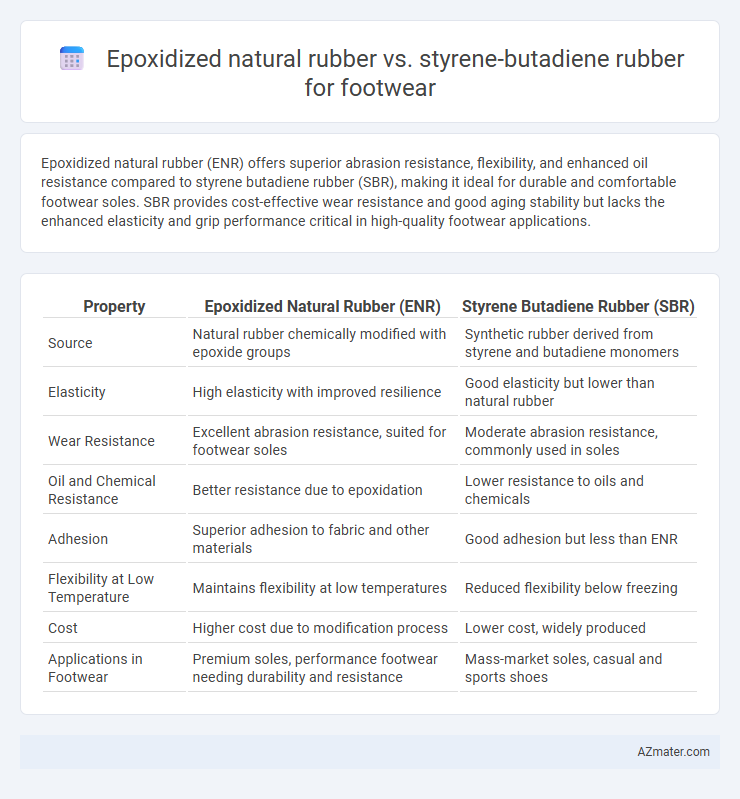Epoxidized natural rubber (ENR) offers superior abrasion resistance, flexibility, and enhanced oil resistance compared to styrene butadiene rubber (SBR), making it ideal for durable and comfortable footwear soles. SBR provides cost-effective wear resistance and good aging stability but lacks the enhanced elasticity and grip performance critical in high-quality footwear applications.
Table of Comparison
| Property | Epoxidized Natural Rubber (ENR) | Styrene Butadiene Rubber (SBR) |
|---|---|---|
| Source | Natural rubber chemically modified with epoxide groups | Synthetic rubber derived from styrene and butadiene monomers |
| Elasticity | High elasticity with improved resilience | Good elasticity but lower than natural rubber |
| Wear Resistance | Excellent abrasion resistance, suited for footwear soles | Moderate abrasion resistance, commonly used in soles |
| Oil and Chemical Resistance | Better resistance due to epoxidation | Lower resistance to oils and chemicals |
| Adhesion | Superior adhesion to fabric and other materials | Good adhesion but less than ENR |
| Flexibility at Low Temperature | Maintains flexibility at low temperatures | Reduced flexibility below freezing |
| Cost | Higher cost due to modification process | Lower cost, widely produced |
| Applications in Footwear | Premium soles, performance footwear needing durability and resistance | Mass-market soles, casual and sports shoes |
Introduction to Footwear Rubber Materials
Footwear rubber materials are essential for providing durability, flexibility, and comfort in shoe manufacturing. Epoxidized natural rubber (ENR) offers enhanced oil resistance, tensile strength, and elasticity compared to conventional natural rubber, making it suitable for resilient outsoles. Styrene butadiene rubber (SBR) is widely used in footwear due to its excellent abrasion resistance and cost-effectiveness, though it generally exhibits lower flexibility and aging resistance than ENR.
Overview of Epoxidized Natural Rubber (ENR)
Epoxidized Natural Rubber (ENR) is a chemically modified form of natural rubber with enhanced oil resistance, elasticity, and abrasion resistance, making it highly suitable for footwear applications requiring durability and comfort. The epoxidation process introduces oxygen atoms into the rubber's molecular structure, improving its polarity and compatibility with fillers and other polymers compared to Styrene Butadiene Rubber (SBR). ENR's superior flexibility and resistance to heat and chemicals provide a significant advantage over SBR in producing lightweight, flexible, and long-lasting footwear materials.
Insights into Styrene Butadiene Rubber (SBR)
Styrene butadiene rubber (SBR) is widely preferred in footwear manufacturing due to its excellent abrasion resistance and cost-effectiveness compared to epoxidized natural rubber (ENR). SBR's balanced properties, including good aging stability and flexibility, make it ideal for durable shoe soles exposed to various environmental conditions. Its synthetic nature ensures consistent quality and performance, positioning SBR as a dominant material in the footwear industry.
Mechanical Properties: ENR vs SBR
Epoxidized natural rubber (ENR) exhibits superior abrasion resistance and enhanced tensile strength compared to styrene butadiene rubber (SBR), making it more durable for footwear applications. ENR offers improved elasticity and resilience under cyclic loading, which contributes to better shock absorption and comfort in shoe soles. SBR, while cost-effective and resistant to aging, generally has lower tear strength and flexibility, limiting its performance in high-stress footwear components.
Abrasion and Wear Resistance Comparison
Epoxidized natural rubber (ENR) exhibits superior abrasion and wear resistance compared to styrene butadiene rubber (SBR) due to its enhanced polarity and crosslink density, leading to better interaction with fillers and improved mechanical strength. ENR's epoxide groups increase resilience against abrasive forces, making it ideal for high-performance footwear outsoles requiring durability and extended service life. In contrast, SBR, while cost-effective and possessing good overall wear characteristics, tends to show faster degradation under rigorous abrasion conditions typical in demanding footwear applications.
Flexibility and Comfort Performance
Epoxidized natural rubber (ENR) offers superior flexibility and enhanced comfort performance compared to Styrene Butadiene Rubber (SBR) in footwear applications due to its higher elasticity and improved damping properties. ENR's unique molecular structure provides excellent resilience and cushioning, reducing foot fatigue during extended wear. Conversely, SBR exhibits good abrasion resistance but lacks the same level of flexibility, making ENR the preferable choice for footwear prioritizing comfort and dynamic movement.
Environmental Impact and Sustainability
Epoxidized natural rubber (ENR) offers superior biodegradability and lower environmental footprint compared to styrene butadiene rubber (SBR), which relies heavily on petrochemical resources and generates more greenhouse gas emissions during production. The renewable origin of ENR supports sustainable sourcing and reduces dependence on non-renewable materials, enhancing circular economy goals in footwear manufacturing. ENR's eco-friendly degradation profile minimizes long-term environmental pollution, making it a preferred choice for sustainable footwear applications.
Cost-Effectiveness in Footwear Production
Epoxidized natural rubber (ENR) offers enhanced cost-effectiveness in footwear production due to its superior abrasion resistance and improved elasticity, reducing material waste and extending product lifespan compared to styrene butadiene rubber (SBR). Although SBR is generally lower in initial cost, ENR's better durability and chemical resistance translate into lower overall manufacturing and maintenance expenses. Manufacturers focusing on sustainable and long-lasting footwear often prefer ENR for its balance of performance and cost efficiency.
Application Suitability: ENR vs SBR in Footwear
Epoxidized Natural Rubber (ENR) offers superior abrasion resistance, flexibility, and oil resistance compared to Styrene Butadiene Rubber (SBR), making it highly suitable for premium footwear requiring durability and comfort. SBR exhibits excellent wear resistance and cost-effectiveness, commonly used in mid-range and mass-produced footwear where budget constraints are significant. ENR's enhanced elasticity and resistance to aging improve footwear lifespan in harsh environments, while SBR's ease of processing suits large-scale manufacturing.
Future Trends in Footwear Rubber Technology
Epoxidized natural rubber (ENR) offers enhanced abrasion resistance, oxygen permeability, and oil resistance, making it a promising alternative to styrene butadiene rubber (SBR) in footwear applications. Future trends indicate a shift towards sustainable, bio-based rubbers like ENR due to increasing environmental regulations and consumer demand for eco-friendly products. Innovations in ENR formulations focus on improving durability and flexibility, positioning it as a key material in next-generation performance footwear technology.

Infographic: Epoxidized natural rubber vs Styrene butadiene rubber for Footwear
 azmater.com
azmater.com